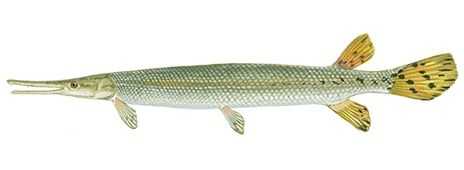Shortnose Gar

Species Details
Lepisosteus Platostomus
Lepisosteidae
Lepisosteiformes
Lake, River, Backwater
5 - 6 lbs.
25" - 35"
Shortnose Gar (Lepisosteus platostomus) Fish Description
Shortnose gar, a freshwater fish native to the United States. They are a primitive fish, a part of the Lepisosteidae family.
With their elongated body and head, and mouth with a row of cone-shaped teeth, the Shortnose gar has a prehistoric-look. Their bodies are armored with interlocking rows of rhomboid ganoid scales. They vary in color, but often have a brown to olive green color above, yellowish sides and white undersides.
Shortnose gars dorsal fins are found almost directly above their anal fins, and by their large caudal fin.
To distinguish the Shortnose gar from other gar species is by the absence of the upper jaw of the alligator gar, the long nose or snout of the longnose gar, and the spottiness or markings of the spotted gar.
Shortnose Gar Diet and Size
Shortnose gar are considered ambush predators. They consume mostly fish but also feed on crustaceans, insects and other invertebrates.
They, in comparison to any other gar, eat more invertebrates, despite devouring any fish available. Shortnose gar has been discovered to exert defensive, territorial behaviours around favored pools when hunting a high number of cicadas. Shortnose gar can grow up to 35 in. in length, but on average are known to reach up to 24.6 in. and weighs up to 6 lbs.
Interesting Facts about Shortnose Gar
- The name of the Shortnose gar is derived from the Greek word “Lepisosteus” that translates to “bony scale,” and “platostomus” meaning “broad mouth.”
- Shortnose gar has the ability to withstand environments with low oxygen levels and turbid conditions, due to their specialized gas bladder. Their gas bladders function similarly to a lung, extracting and utilising oxygen from the air they swallow, in addition to their regulating buoyancy.
Fishing Techniques
There are many different ways for anglers to catch garfish, such as drift fishing, fly fishing, trolling, bait casting, still fishing, and spin casting. And many lures, and baits that you can choose from the likes of cut bait, flies, minnows, and more.
Summer, or the hotter months of the year, would be great. With just the right eaters, you'll have little to no trouble in finding garfish. Near dawn, dusk or at night, especially, you'll be able to hear them rolling noisily near the surface, as they come up for air to breathe using their gas bladders. The Shortnose gar can be found in different waters, but it's better to do your fishing in oxbow lakes, bayous, and slow delta rivers.
Considering the average size of the Shortnose gar, it is quite a smaller fish of the gar kind. A durable rod and reel with a 15-25 pound test line would be enough.
Anglers must be extremely patient to be successful in fishing for a gar. When there is a sight of a gar by the surface, cast a baitfish-imitation plug close, but not too close, to the front of the gar. You must let the lure remain still, with exception to the occasional twitch. The gar would soon propel itself toward the bait with sly flicks using its fins when it is actively feeding. No expectations of a reckless headfirst swim towards the plug instead, the gar would disguise itself as a stick or a log moving tentatively and slowly.
Do not by any means move the lure when you can see your target moving towards it! As long as the bait stays still, the gar will continue to swim towards it until it's alongside, near its head.
Now, the garfish will be remaining at a stock-still for as long as the lure is the same. Giving the bait the smallest motion, and the gar will take it in with a sudden jerk movement of its head. Try and set the hook with a hard upward pull of your rod. If you're lucky, you'll manage to pull the gar up in the air. If not, set yourself up for the next gamefish.
Habitat and Distribution
The Shortnose gar primarily are found inhabiting the Great Lakes south towards the Gulf of Mexico. But they are essentially limited at the lower gradient portions of the Mississippi River basin. Where there in the north, would lead to a broad range in the river systems from southern Ohio to Montana that feed the Mississippi.
With their gas bladder, they can withstand higher turbidity than most gars. Shortnose gar fish are commonly found living in calm waters by large rivers and their backwaters. They also inhabit oxbow lakes, and large, quiet pools usually around where little to no aquatic vegetation occurs.






